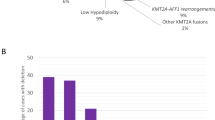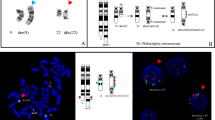Abstract
The dicentric chromosome (9;20) (dic(9;20)) is described in 2 % of childhood B-acute lymphoblastic leukaemia. Fluorescence in situ hybridization (FISH) is the most reliable method to identify dic(9;20) when compared with conventional cytogenetics. To define the prognostic importance of dic(9;20), we evaluated treatment response and patient survival. This was a retrospective study in three French university centres. Patients’ clinical and laboratory characteristics and treatment response are described. Nine children with dic(9;20) have been identified since 1995. All patients had at least one poor prognostic feature either among the clinical features, the initial laboratory results or in the initial treatment response: central nervous system involvement (2/9), high median leucocyte count (≥50 G/L) (8/9) and poor response to prednisone (2/9). All patients were in complete cytological remission after induction therapy but only three had a good molecular response with minimal residual disease (MRD) <10−3. Five out of nine patients relapsed and two died, 4 and 12 months after diagnosis, respectively. The event-free survival rate in this population was 44 % (95 % confidence interval (CI) = 0.09–0.79) and overall survival 78 % (95 % CI = 0.51–1.05). In this population, dic(9;20) is associated with a relatively poor prognosis. Patients showing dic(9;20), whether this cytogenetic abnormality is associated with other poor prognostic factors or not, should be identified at the outset in order to be offered a more intensive treatment protocol.
Similar content being viewed by others
References
Pichler H, Möricke A, Mann G et al (2010) Prognostic relevance of dic(9;20)(p11;q13) in childhood B-cell precursor acute lymphoblastic leukaemia treated with Berlin-Frankfurt-Münster (BFM) protocols containing an intensive induction and post-induction consolidation therapy. Br J Haematol 149:93–100. doi:10.1111/j.1365-2141.2009.08059.x
Forestier E, Gauffin F, Andersen MK et al (2008) Clinical and cytogenetic features of pediatric dic(9;20)(p13.2;q11.2)-positive B-cell precursor acute lymphoblastic leukemias: a Nordic series of 24 cases and review of the literature. Gene Chromosome Cancer 47:149–158. doi:10.1002/gcc.20517
Clark R, Byatt SA, Bennett CF et al (2000) Monosomy 20 as a pointer to dicentric (9;20) in acute lymphoblastic leukemia. Leukemia 14:241–246
Rieder H, Schnittger S, Bodenstein H et al (1995) Dic(9;20): a new recurrent chromosome abnormality in adult acute lymphoblastic leukemia. Gene Chromosome Cancer 13:54–61
Heerema NA, Maben KD, Bernstein J et al (1996) Dicentric (9;20)(p11;q11) identified by fluorescence in situ hybridization in four pediatric acute lymphoblastic leukemia patients. Cancer Genet Cytogenet 92:111–115
Li T, Xue Y, Zhang J et al (2008) Isodicentric 20q- in two cases of B-cell acute lymphocytic leukemia with the respective t(9;20)(p11;q11.2) and t(9;22)(q34;q11.2). Cancer Genet Cytogenet 181:55–59. doi:10.1016/j.cancergencyto.2007.11.003
Slater R, Smit E, Kroes W et al (1995) A non-random chromosome abnormality found in precursor-B lineage acute lymphoblastic leukaemia: dic(9;20) (p13;q11). Leukemia 9:1613–1619
Song X, Gong S, Yang J, Wang J (2007) Clinical and molecular cytogenetic characteristics of dic(9;20) in adult acute lymphoblastic leukemia: a case report of three patients. Ann Hematol 86:347–351. doi:10.1007/s00277-007-0255-0
Zachariadis V, Gauffin F, Kuchinskaya E et al (2011) The frequency and prognostic impact of dic(9;20)(p13.2;q11.2) in childhood B-cell precursor acute lymphoblastic leukemia: results from the NOPHO ALL-2000 trial. Leukemia 25:622–628. doi:10.1038/leu.2010.318
Béné MC, Boumsell L, Vannier JP et al (1989) Immunologic analysis of a thousand cases of acute leukemia. French Groupe d’Etude Immunologique des Leucémies (GEIL). Nouv Rev Française Hématologie 31:133–136
Garand R, Beldjord K, Cavé H et al (2013) Flow cytometry and IG/TCR quantitative PCR for minimal residual disease quantitation in acute lymphoblastic leukemia: a French multicenter prospective study on behalf of the FRALLE, EORTC and GRAALL. Leukemia 27:370–376. doi:10.1038/leu.2012.234
Gandemer V, Chevret S, Petit A et al (2012) Excellent prognosis of late relapses of ETV6/RUNX1-positive childhood acute lymphoblastic leukemia: lessons from the FRALLE 93 protocol. Haematologica 97:1743–1750. doi:10.3324/haematol.2011.059584
Domenech C, Suciu S, De Moerloose B et al (2014) Dexamethasone (6 Mg/m2/day) and prednisolone (60 Mg/m2/day) were equally effective as induction therapy for childhood acute lymphoblastic leukemia in the EORTC CLG 58951 randomized trial. Haematologica 99:1220–1227. doi:10.3324/haematol.2014.103507
Smith M, Arthur D, Camitta B et al (1996) Uniform approach to risk classification and treatment assignment for children with acute lymphoblastic leukemia. J Clin Oncol Off J Am Soc Clin Oncol 14:18–24
Cavé H, Van der Werff ten Bosch J, Suciu S (1998) Clinical significance of minimal residual disease in childhood acute lymphoblastic leukemia. European Organization for Research and Treatment of Cancer—Childhood Leukemia Cooperative Group. N Engl J Med 339:591–598. doi:10.1056/NEJM199808273390904
Mitelman F, Johansson B, Mertens F (2014) Mitelman database of chromosome aberration and gene fusions in cancer.
Lönnerholm G, Nordgren A, Frost B-M et al (2009) Dic(9;20)(p13;q11) in childhood acute lymphoblastic leukaemia is related to low cellular resistance to asparaginase, cytarabine and corticosteroids. Leukemia 23:209–212. doi:10.1038/leu.2008.179
Kuchinskaya E, Heyman M, Nordgren A et al (2011) Interphase fluorescent in situ hybridization deletion analysis of the 9p21 region and prognosis in childhood acute lymphoblastic leukaemia (ALL): results from a prospective analysis of 519 Nordic patients treated according to the NOPHO-ALL 2000 protocol. Br J Haematol 152:615–622. doi:10.1111/j.1365-2141.2010.08532.x
Schoumans J, Johansson B, Corcoran M et al (2006) Characterisation of dic(9;20)(p11-13;q11) in childhood B-cell precursor acute lymphoblastic leukaemia by tiling resolution array-based comparative genomic hybridisation reveals clustered breakpoints at 9p13.2 and 20q11.2. Br J Haematol 135:492–499. doi:10.1111/j.1365-2141.2006.06328.x
An Q, Wright SL, Moorman AV et al (2009) Heterogeneous breakpoints in patients with acute lymphoblastic leukemia and the dic(9;20)(p11-13;q11) show recurrent involvement of genes at 20q11.21. Haematologica 94:1164–1169. doi:10.3324/haematol.2008.002808
Strefford JC, An Q, Harrison CJ (2009) Modeling the molecular consequences of unbalanced translocations in cancer: lessons from acute lymphoblastic leukemia. Cell Cycle Georget Tex 8:2175–2184
Conflict of interest
The authors declare that they have no conflict of interest.
Author information
Authors and Affiliations
Corresponding author
Electronic supplementary material
Below is the link to the electronic supplementary material.
ESM 1
(PDF 39 kb)
Rights and permissions
About this article
Cite this article
Letouzey, M., Penther, D., Roche-Lestienne, C. et al. Detection of dicentric chromosome (9;20) in paediatric B-cell acute lymphoblastic leukaemia: prognostic significance. Ann Hematol 94, 187–193 (2015). https://doi.org/10.1007/s00277-014-2204-z
Received:
Accepted:
Published:
Issue Date:
DOI: https://doi.org/10.1007/s00277-014-2204-z




